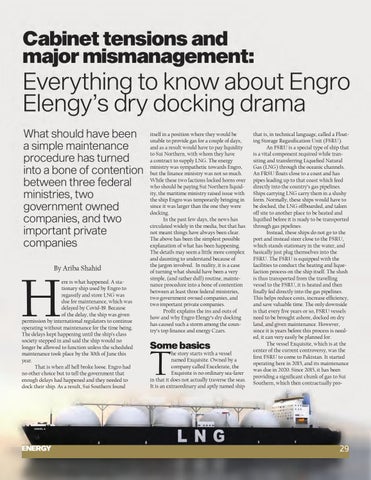By Ariba Shahid
H
ere is what happened. A stationary ship used by Engro to regassify and store LNG was due for maintenance, which was delayed by Covid-19. Because of the delay, the ship was given permission by international regulators to continue operating without maintenance for the time being. The delays kept happening until the ship’s class society stepped in and said the ship would no longer be allowed to function unless the scheduled maintenance took place by the 30th of June this year. That is when all hell broke loose. Engro had no other choice but to tell the government that enough delays had happened and they needed to dock their ship. As a result, Sui Southern found
ENERGY
itself in a position where they would be unable to provide gas for a couple of days, and as a result would have to pay liquidity to Sui Northern, with whom they have a contract to supply LNG. The energy ministry was sympathetic towards Engro, but the finance ministry was not so much. While these two factions locked horns over who should be paying Sui Northern liquidity, the maritime ministry raised issue with the ship Engro was temporarily bringing in since it was larger than the one they were docking. In the past few days, the news has circulated widely in the media, but that has not meant things have always been clear. The above has been the simplest possible explanation of what has been happening. The details may seem a little more complex and daunting to understand because of the jargon involved. In reality, it is a case of turning what should have been a very simple, (and rather dull) routine, maintenance procedure into a bone of contention between at least three federal ministries, two government owned companies, and two important private companies. Profit explains the ins and outs of how and why Engro Elengy’s dry docking has caused such a storm among the country’s top finance and energy Czars.
Some basics
T
he story starts with a vessel named Exquisite. Owned by a company called Excelerate, the Exquisite is no ordinary sea-farer in that it does not actually traverse the seas. It is an extraordinary and aptly named ship
that is, in technical language, called a Floating Storage Regasification Unit (FSRU). An FSRU is a special type of ship that is a vital component required while transiting and transferring Liquefied Natural Gas (LNG) through the oceanic channels. An FRSU floats close to a coast and has pipes leading up to that coast which feed directly into the country’s gas pipelines. Ships carrying LNG carry them in a slushy form. Normally, these ships would have to be docked, the LNG offboarded, and taken off site to another place to be heated and liquified before it is ready to be transported through gas pipelines. Instead, these ships do not go to the port and instead steer close to the FSRU, which stands stationary in the water, and basically just plug themselves into the FSRU. The FSRU is equipped with the facilities to conduct the heating and liquefaction process on the ship itself. The slush is thus transported from the travelling vessel to the FSRU, it is heated and then finally fed directly into the gas pipelines. This helps reduce costs, increase efficiency, and save valuable time. The only downside is that every five years or so, FSRU vessels need to be brought ashore, docked on dry land, and given maintenance. However, since it is years before this process is needed, it can very easily be planned for. The vessel Exquisite, which is at the center of the current controversy, was the first FSRU to come to Pakistan. It started operating here in 2015, and its maintenance was due in 2020. Since 2015, it has been providing a significant chunk of gas to Sui Southern, which then contractually pro-
29







